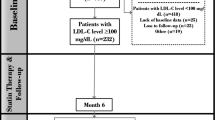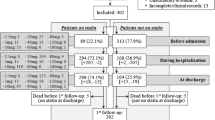Abstract
Purpose
It is unknown if acute coronary syndrome (ACS) patients presenting with advanced Killip class (III/IV) would benefit from early statin therapy. Therefore, we aimed to explore the relationship between statin therapy within the first 24 h of medical contact and in-hospital outcomes in this patient population in a nationwide registry.
Method
In the Improving Care for Cardiovascular Disease in China—ACS project, among ACS patients presenting with Killip class III/IV, we performed the following three analyses: (i) the associations between early statin therapy and risks for in-hospital mortality and ischaemic events; (ii) the dose effect of statins on mortality and (iii) the interaction between low-density lipoprotein cholesterol (LDL-C) levels and statins on mortality.
Result
Among 104,516 ACS patients, 12,149 presented with advanced Killip class and 89.3% received early statins. Multivariable-adjusted logistic regression models revealed a 69% reduction in mortality in the statin group (adjusted odds ratio [OR] 0.31; 95% confidence interval [CI] 0.25–0.39), parallel with a reduction in ischaemic events (adjusted OR 0.50, 95% CI 0.33–0.74), compared with those not receiving early statins, which was consistent in multiple sensitivity analyses. Additionally, the protective association of early statins on in-hospital mortality was observed even among patients that received a low-to-moderate dose. Finally, the short-term survival benefit of early statins was independent of LDL-C.
Conclusion
In a nationwide ACS registry, statin therapy initiated within the first 24 h of medical contact was associated with a reduced risk of in-hospital mortality in ACS patients presenting with advanced Killip class.






Similar content being viewed by others
References
Itzahki Ben Zadok O, Ben-Gal T, Abelow A, et al. Temporal trends in the characteristics, management and outcomes of patients with acute coronary syndrome according to their Killip class. Am J Cardiol. 2019;124(12):1862–8.
Garot P, Bendaoud N, Lefèvre T, Morice M-C. Favourable effect of statin therapy on early survival benefit at the time of percutaneous coronary intervention for ST-elevation myocardial infarction and shock. EuroIntervention. 2010;6(3):350–5.
Sim D, Jeong M, Cho K, et al. Effect of early statin treatment in patients with cardiogenic shock complicating acute myocardial infarction. Korean Circ J. 2013;43(2):100–9.
Fonarow GC, Wright RS, Spencer FA, et al. Effect of statin use within the first 24 hours of admission for acute myocardial infarction on early morbidity and mortality. Am J Cardiol. 2005;96(5):611–6.
Collet J-P, Thiele H, Barbato E, et al. 2020 ESC guidelines for the management of acute coronary syndromes in patients presenting without persistent ST-segment elevation: the task force for the management of acute coronary syndromes in patients presenting without persistent ST-segment elevation of the European Society of Cardiology (ESC). Eur Heart J. 2020;42(14):1289–367.
Ibanez B, James S, Agewall S, et al. 2017 ESC Guidelines for the management of acute myocardial infarction in patients presenting with ST-segment elevation: the task force for the management of acute myocardial infarction in patients presenting with ST-segment elevation of the European Society of Cardiology (ESC). Eur Heart J. 2018;39(2):119–77.
Wang C, Liu P, Liao J. Pleiotropic effects of statin therapy: molecular mechanisms and clinical results. Trends Mol Med. 2008;14(1):37–44.
Rosenson R, Tangney C. Antiatherothrombotic properties of statins: implications for cardiovascular event reduction. JAMA. 1998;279(20):1643–50.
Briel M, Schwartz G, Thompson P, et al. Effects of early treatment with statins on short-term clinical outcomes in acute coronary syndromes: a meta-analysis of randomized controlled trials. JAMA. 2006;295(17):2046–56.
Mendieta G, Ben-Aicha S, Gutiérrez M, et al. Intravenous statin administration during myocardial infarction compared with oral post-infarct administration. J Am Coll Cardiol. 2020;75(12):1386–402.
Hao Y, Liu J, Liu J, et al. Rationale and design of the Improving Care for Cardiovascular Disease in China (CCC) project: a national effort to prompt quality enhancement for acute coronary syndrome. Am Heart J. 2016;179:107–15.
Gillum R, Fortmann S, Prineas R, Kottke T. International diagnostic criteria for acute myocardial infarction and acute stroke. Am Heart J. 1984;108(1):150–8.
Grundy S, Stone N, Bailey A, et al. 2018 AHA/ACC/AACVPR/AAPA/ABC/ACPM/ADA/AGS/APhA/ASPC/NLA/PCNA guideline on the management of blood cholesterol: a report of the American College of Cardiology/American Heart Association Task Force on Clinical Practice Guidelines. Circulation. 2019;139(25):e1082–143.
Levey A, Stevens L, Schmid C, et al. A new equation to estimate glomerular filtration rate. Ann Intern Med. 2009;150(9):604–12.
van der Molen AJ, Reimer P, Dekkers IA, et al. Post-contrast acute kidney injury—part 1: definition, clinical features, incidence, role of contrast medium and risk factors. Eur Radiol. 2018;28(7):2845–55.
Kohsaka S, Menon V, Lowe A, et al. Systemic inflammatory response syndrome after acute myocardial infarction complicated by cardiogenic shock. Arch Intern Med. 2005;165(14):1643–50.
Nohria A, Prsic A, Liu P, et al. Statins inhibit Rho kinase activity in patients with atherosclerosis. Atherosclerosis. 2009;205(2):517–21.
Saab FA, Petrina M, Kline-Rogers E, et al. Early statin therapy in elderly patients presenting with acute coronary syndrome causing less heart failure. Indian Heart J. 2006;58(4):321–4.
Lopes R, de Barros E Silva P, de Andrade Jesuíno I, et al. Timing of loading dose of atorvastatin in patients undergoing percutaneous coronary intervention for acute coronary syndromes: insights from the SECURE-PCI randomized clinical trial. JAMA Cardiol. 2018;3(11):1113–8.
Ma M, Bu L, Shi L, et al. Effect of loading dose of atorvastatin therapy prior to percutaneous coronary intervention in patients with acute coronary syndrome: a meta-analysis of six randomized controlled trials. Drug Des Dev Ther. 2019;13:1233–40.
Berwanger O, Guimaraes HP, Laranjeira LN, et al. Effect of a multifaceted intervention on use of evidence-based therapies in patients with acute coronary syndromes in Brazil: the BRIDGE-ACS randomized trial. JAMA. 2012;307(19):2041–9.
Amarenco P, Bogousslavsky J, Callahan A, et al. High-dose atorvastatin after stroke or transient ischemic attack. N Engl J Med. 2006;355(6):549–59.
Sun L, Clarke R, Bennett D, et al. Causal associations of blood lipids with risk of ischemic stroke and intracerebral hemorrhage in Chinese adults. Nat Med. 2019;25(4):569–74.
Ma C, Gurol M, Huang Z, et al. Low-density lipoprotein cholesterol and risk of intracerebral hemorrhage: a prospective study. Neurology. 2019;93(5):e445–57.
Zhang X, Liu J, Wang M, et al. Twenty-year epidemiologic study on LDL-C levels in relation to the risks of atherosclerotic event, hemorrhagic stroke, and cancer death among young and middle-aged population in China. J Clin Lipidol. 2018;12(5):1179-1189.e4.
Guptill J, Mehta R, Armstrong P, et al. Stroke after primary percutaneous coronary intervention in patients with ST-segment elevation myocardial infarction: timing, characteristics, and clinical outcomes. Circ Cardiovasc Interv. 2013;6(2):176–83.
Acknowledgements
The authors thank all hospitals participating in the CCC-ACS project for their invaluable contribution to this work; see the electronic supplementary material, Table 6S.
Author information
Authors and Affiliations
Consortia
Corresponding authors
Ethics declarations
Ethics approval and consent to participate
The CCC-ACS project was approved by the institutional review board of Beijing Anzhen Hospital, Capital Medical University, with a waiver for informed consent.
Consent for publication
Not applicable.
Availability of data and materials
The data and study materials will be made available for onsite audits by third parties for the purposes of reproducing the results or replicating the procedure.
Code availability
Not applicable.
Competing interests
The authors have declared that no competing interests exist.
Funding
The CCC-ACS project is a collaborative project of the American Heart Association and the Chinese Society of Cardiology. The American Heart Association received funding from Pfizer through an independent grant for learning and change and AstraZeneca as a quality improvement initiative. This work was also supported by the National Key R&D Program of China (Nos. 2020YFC2004700, 2020YFC2004706).
Authors' contributions
All authors contributed to the study conception and design. Material preparation, data collection and analysis were performed by XS. The first draft of the manuscript was written by XS and all authors commented on previous versions of the manuscript. All authors read and approved the final manuscript.
Disclosure of potential conflicts of interest
Xiwen Song, Xin Zhou, Ziping Li, Haonan Sun, Hangkuan Liu, Geru A, Yongchen Hao, Jing Liu, Jun Liu, Dong Zhao, Qing Yang and Yongle Li declare that they have no conflicts of interest.
Research involving Human Participants and/or Animals
This study involved human participants, with a waiver for informed consent.
Informed consent
Informed consent was waived for this study.
Additional information
A complete list of CCC-ACS investigators is given in the electronic supplementary material, Table 6S.
Supplementary Information
Below is the link to the electronic supplementary material.
Rights and permissions
Springer Nature or its licensor holds exclusive rights to this article under a publishing agreement with the author(s) or other rightsholder(s); author self-archiving of the accepted manuscript version of this article is solely governed by the terms of such publishing agreement and applicable law.
About this article
Cite this article
Song, X., Zhou, X., Li, Z. et al. Early Statin Therapy and In-Hospital Outcomes in Acute Coronary Syndrome Patients Presenting with Advanced Killip Class at Admission: Findings from the CCC-ACS Project. Am J Cardiovasc Drugs 22, 685–694 (2022). https://doi.org/10.1007/s40256-022-00546-5
Accepted:
Published:
Issue Date:
DOI: https://doi.org/10.1007/s40256-022-00546-5




